Quick Look
Grade Level: High school
Time Required: 1 hour
Expendable Cost: US $10.00
Group Size: 1
Subject Areas: Science and Technology
Introduction
Bolded words are vocabulary and concepts to highlight with students during the activity.
Students build their own solar USB chargers that need nothing but the sun to charge a phone or other USB devices. They learn about parallel and series connections, solar panels, batteries, diodes, and more! Then, they assemble the components to build chargers that they can take with them anywhere, harnessing the energy of the sun to charge their devices. Engineers are continuously designing new technologies to take advantage of the sun’s plentiful rays. Like electrical engineers, students design circuits to efficiently capture energy from the sun and convert it to electricity for many uses.
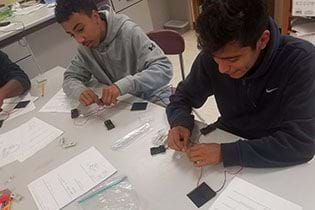
Supplies
Each group needs:
- 2 mini solar panels
- 4 AA NiMH rechargeable batteries
- 2 2xAA battery holders
- 1 Schottky diode (1N5817)
- 1 USB connector (female)
- case, such as a pencil case or small box
- wire
- paper and pencils
- (optional, to charge Apple devices) a fairly simple voltage divider circuit to add to the circuit; see https://learn.sparkfun.com/tutorials/voltage-dividers
For the class to share:
- wire strippers
- needle nose pliers
- multimeter
- USB test wire
- soldering iron and solder
- electrical tape
Subscribe
Get the inside scoop on all things TeachEngineering such as new site features, curriculum updates, video releases, and more by signing up for our newsletter!Procedure
Overview
Students undertake an engineering challenge to design and build solar USB chargers using solar panels, rechargeable batteries, and other components.
Procedure
- In the form of a class discussion, lead students through the following introductory questions:
Q1: What is the voltage of a NiMH AA battery? What is the voltage of four AA batteries connected in parallel? What is the voltage of four AA batteries connected in series? (Answer: Voltage of one NiMH AA battery is about 1.2 V. Four batteries in parallel: 0.3V. Four batteries in series: 4.8 V.)
Q2: What is the output voltage of the solar panel? What is the output voltage of two panels connected in parallel? What is the output voltage of two panels connected in series? (Answer: The answer depends on the solar panels chosen for the activity [for example, SparkFun sells solar panels that have a peak power output of 6 V]. For solar panels that have individual outputs of about 0.55 V [indoor lighting], two panels connected in parallel: 0.54 V. Two panels connected in series: 1.09 V. Their output mirrors the behavior of batteries in series/parallel.)
Q3: What do the solar panels do? Where do you think they should be placed in the circuit? (Answer: Solar panels convert light energy to electrical energy; they act like batteries and produce a voltage output. In this circuit, the solar panels provide power to recharge the batteries. Place the positive output of solar panel to the positive output of the battery pack.)
Q4: Why do you think that batteries are used? Where do you think they should be placed in the circuit? (Answer: The batteries store power from the solar panels so that you can charge your device when the sun is not out. Place them positive to positive, and negative to negative with the solar panels.)
Q5: What does the diode do? Where do you think it should be placed in the circuit? (Answer: The diode ensures that the current only runs one way. Place it between the positive terminal of the solar panel and the positive terminal of the battery, in such a way that the current flows only from the solar panels to the battery. This prevents the battery from discharging through the solar panel at night.)
Q6: At what voltage does a USB supply operate? (Answer: 5V)
Q7: Given our discussion, sketch a diagram that shows how you think the components should be arranged. (Answer: See the circuit diagram below.)
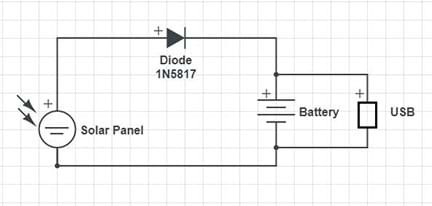
- Distribute materials and direct students to build and test according to steps 3-11.
- Connect the battery holders and measure the voltage. Once students have determined the correct way to connect the batteries, have them connect the leads (wires) of the battery holders appropriately. (To connect them in series, connect the red wire of one holder to the black wire of another. To connect the leads in parallel, connect the two red wires together and the two black wires together.) Connect the wires together by twisting the ends of the leads (which have been previously stripped of insulation) and twisting, as shown in Figure 1. The wrapping pattern is designed to cause the termination to tighten as the conductors pull against each other.
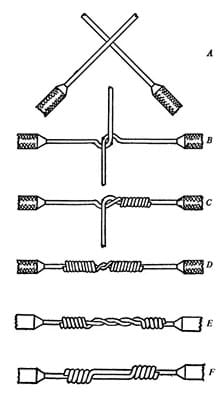
Install the AA batteries into the holders. To measure the battery voltage, have students use a multimeter and connect the black lead to the COM terminal and the red lead to the terminal with V listed next to it. Then set the multimeter to read DC voltage (as shown in Figure 2). Provide assistance to anyone who is unfamiliar with setting-up a multimeter.
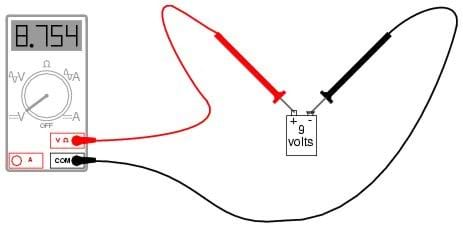
Have students touch the black probe to the stripped end of the black wire from the battery holders, and the red probe to the stripped end of the red wire from the battery holders. Tell students to record the voltage and compare it to the answer from introductory question 1. If a major discrepancy exists, encourage students to find the source of error, correct it, and repeat the measurement.
- Connect the solar panels and measure the open circuit voltage. Once students have determined the correct way to connect the solar panels, have them repeat the above procedure for connecting and testing the voltage of the solar panels. Have students compare the measured voltage to the answer from Introductory Question 2. If a major discrepancy exists, tell students to find the source of error, correct it, and repeat the measurement.
- Connect the diode. Diodes have polarity, so make sure students identify the positive and negative leads of the diode according to Figure 3. Have students connect the positive side of the diode to the positive wire from the solar panels by twisting the leads together as shown in Figure 1. (Note: If students are putting the solar panel on top of a case, direct them to thread the solar panel wires through the case before making any connections.) Later, once the charger is tested, these connections will be soldered, but they must have a good mechanical connection to work for the test.
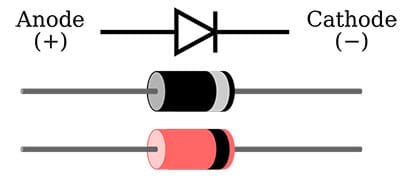
- Connect the battery holder. Have students connect the positive wire of the battery holders to the negative lead of the diode, and the negative wire of the battery connector to the negative wire from the solar panel using the same twisting wires method from the previous step.
- Connect the USB port. Have students connect the positive (red) wire of the USB port to the junction containing the positive wire of the battery holder, and the negative wire of the boost connector to the junction containing the negative wire of the battery holder by twisting the wires together as shown in Figure 4. Make sure that students twist the wires firmly together so that they do not come apart while testing.
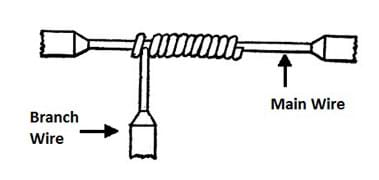
- Test your system. Now, have students plug in the USB test wire into the USB port. Using the same multimeter setup as steps 3 and 4, tell students to measure the voltage across the USB test wire leads and record this voltage. (Expect the voltage to be ~5V; if not, look for a faulty component or faulty assembly.)
- (optional) Install a voltage divider circuit to enable charging of Apple devices. If students want their USB chargers to work for Apple devices, a fairly simple voltage divider circuit needs to be added. See a tutorial on voltage dividers at https://learn.sparkfun.com/tutorials/voltage-dividers. Have students read through this tutorial and design a voltage divider for their solar charger circuits.
- Solder and insulate connections. Once the charger has been tested, tell students that the connections need to be made permanent by soldering. Solder the connections together for them. (See the Other section for recommended soldering tutorials.) Then, have students wrap electrical tape around the connections to insulate them.
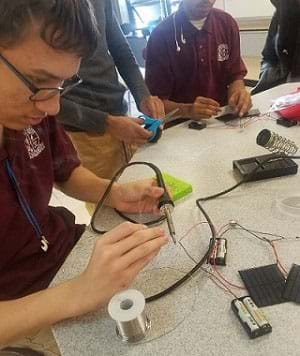
- Assemble completed circuit into case. Have students assemble their components into their cases, as desired. Look over their work and make sure that all connections are correctly insulated.
Wrap Up - Thought Questions
- Why are batteries used in the circuit? (Answer: Batteries are used so you can charge a device even when no sunlight is available to charge the solar panels.)
- What is the main purpose of the solar panels? (Answer: To charge the rechargeable batteries.)
- What does the diode do? (Answer: Directs the current so that the batteries do not discharge through the solar panels at night.)
Other Related Information
If unfamiliar with soldering, refer to the following good “how to solder” tutorials at https://learn.sparkfun.com/tutorials/how-to-solder-through-hole-soldering and http://www.aaroncake.net/electronics/solder.htm. If time and materials permit, or if students already have experience soldering, have them solder their circuits together themselves.
Copyright
© 2017 by Regents of the University of Colorado; original © 2015 University of ConnecticutContributors
Neal Sherman; Karen BeitlerSupporting Program
The Joule Fellows Program (NSF-RET), School of Engineering, University of ConnecticutAcknowledgements
This activity was developed by The Joule Fellows - Teachers in Sustainable Technologies Research Laboratories RET Program at the University of Connecticut, funded by National Science Foundation RET grant no. EEC 1403428. However, these contents do not necessarily represent the policies of the NSF, and you should not assume endorsement by the federal government.
Last modified: May 12, 2022






User Comments & Tips